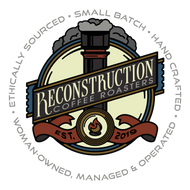
There are many, many, many articles and videos online about how to chase the perfect cup of coffee through experimentation with the Hario V60 pour over set. In my opinion, here is the simplest way to begin. (I use a Hario size 2 pour over set, the same one we sell on our website.)
- Use your Hario glass server to measure out 500ml of water.
- Pour the water into a kettle to boil.
- While waiting for the water to boil, place one Hario filter inside the size ceramic V-shaped dripper, then place the dripper on top of the glass server.
- Put two scoops (use the scoop that comes with the dripper!) of ground coffee into the filter.
- Once the water reaches boiling, turn off the heat and wait a few seconds, to let it cool back down just a bit, then slowly pour hot water over the grounds until you’ve just covered them.
- Wait 30 seconds for your fresh coffee to bloom. (That’s the bubbles you’ll see popping up from the coffee!)
- Slowly, and in a circular motion, pour some more water over the grounds and stop just before you reach the top of the dripper. Let the water drip through, and then slowly pour again until you’ve used up your water, or you see the coffee fill the pot to about 450-500ml.
- Enjoy that coffee!
This is only where the fun BEGINS!
Depending on how you like your coffee, you can make little adjustments to change the taste next time you brew. The three main ways to alter the taste with the pour over method are pour speed, grind size, and coffee-to-water ratio.
For a richer taste, try pouring more slowly. For a lighter brew, pour a little faster.
If the taste is too sour or seems weak, a finer grind might be your preference. If the taste is too bitter or seems harsh, try a coarser grind.
When you want to start experimenting with ratios, I highly suggest using a kitchen scale with a tare function. With this simple and inexpensive kitchen tool, you can really start to zero in on your perfect cup. Start with a ratio of 1 gram coffee to 16 grams water. Too weak? Try 1:15. Too strong? Try 1:17.
PRO TIP: Sometimes the paper filter can slightly alter the taste of the coffee. To avoid this, rinse a little hot water all over the filter BEFORE you put the coffee in, to wash the paper taste away.
And if you’ve already tried a pour over, and you’re still not sure what the fuss is about? Make sure you’re not making these most common pour over mistakes:
- Pouring water down the side of the filter. It is tempting to try to use the water to push all of the grounds away from the edges and into the center of the cone, but that will cause the water to drip through the filter rather than through the coffee, and your cup will be watery. Instead, pour in concentric circles from the center out and AVOID letting the water touch the filter directly.
- Pouring water when it is too hot. Don’t burn that coffee! Once you get to a boil, give it a few seconds off the heat to cool down a touch. If you really want to get scientific about it, get an electric gooseneck kettle that allows you to set and hold to the temperature that you want. 200 degrees (F) is a good place to start.
- Using old coffee. Coffee is a living thing, and the flavor changes as time goes by. No, it doesn’t stay fresher if you put it in the freezer. We think our coffee is most flavorful when ground right before brewing. You will also get the most complex flavors in the approximately one to four weeks after the “roasted on” date. After that, coffee starts to get a little flat, especially if you’ve already opened the airtight bag. This is why we sell 12oz bags rather than 16oz bags. We’d rather you buy small amounts more frequently so that the coffee your drinking is always as fresh as it can be. We don’t believe you should stock up with 3 months’ worth of fresh coffee any more than we think you should stock up on 3 months’ worth of fresh milk!
Any other pour over questions? Send us an email at roaster@reconstructioncoffee.com!

Leave a comment